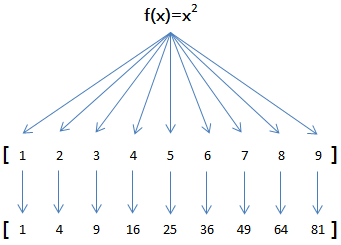Python3常用内置方法代码实例
这篇文章主要介绍了Python3常用内置方法代码实例,文中通过示例代码介绍的非常详细,对大家的学习或者工作具有一定的参考学习价值,需要的朋友可以参考下
max()/min()
- 传入一个参数 (可迭代对象), 返回这个可迭代对象中最大的元素
- 可以设置default关键字参数, 当这个可迭代对象为空时, 返回default的值
- 传入多个参数, 返回这些参数中最大的参数
- 多个参数必须是同类型的
- 两种方法都可以设置key关键字参数(传入函数)
""" max(iterable, *[, default=obj, key=func]) -> value max(arg1, arg2, *args, *[, key=func]) -> value With a single iterable argument, return its biggest item. The default keyword-only argument specifies an object to return if the provided iterable is empty. With two or more arguments, return the largest argument. """ res = max([1, 2, 3], default=0) print(res) # 3 # 传入了一个空的可迭代的对象参数, 返回默认值0 res = max([], default=0) print(res) # 0 lis = [1, 2, 3] def func(num): return -num # res = max(lis, key=func) res = max(lis, key=lambda num: -num) print(res) # 1 """ key参数接收的是一个函数对象 max函数会将lis里面的元素依次传入转换函数 哪个元素经过转换函数得到的值最大, 就返回该元素 """
filter() 过滤
- 第一个参数(形参), 要么是func, 要么是None, 不传会报错
- 第二个参数是可迭代对象
- 返回一个filter obj (iterator)
- filter()方法会过滤掉:
- 本身布尔值为False的元素
- 经过函数处理后, 返回值的布尔值为False的元素
"""
filter(function or None, iterable) --> filter object
Return an iterator yielding those items of iterable for which function(item) is true. If function is None, return the items that are true.
"""
"""
需要传入两个参数, 第一个是函数或者None, 第二个是可迭代对象
返回的是一个filter obj(迭代器)
如果第一个参数时None, 则返回的迭代器中只包含可迭代对象中为True的元素
如果第一参数是一个函数, 可迭代对象中元素传入该函数, 结果为True, 则filter方法返回的迭代器就会包含此元素
"""
lis = [0, 1, 2, 3]
filter_obj = filter(None, lis)
print(list(filter_obj)) # [1, 2, 3]
def func(num):
if num > 1:
return 0
filter_obj = filter(func, lis)
print(list(filter_obj)) # []
filter_obj = filter(lambda num: num > 1, lis)
print(list(filter_obj)) # [2, 3]
map() 映射
- 第一个参数必须是函数
- 后面可传入一个或多个可迭代对象参数
- 可迭代对象参数的个数, 必须和函数的参数个数相同
- 多个可迭代对象包含的元素个数不一致, 则以元素个数最少的那个为准
- 返回一个map obj (iterator)
""" map(func, *iterables) --> map object Make an iterator that computes the function using arguments from each of the iterables. Stops when the shortest iterable is exhausted. """ def func1(x): return x + 1 """ 参数1: 函数, 参数2:可迭代对象 1.可迭代对象的中的元素依次传入函数得到返回值res 2.调用map函数最终会得到一个迭代器对象iterator 3. 这个iterator就包含了res """ map_obj = map(func1, [1, 2, 3]) print(list(map_obj)) # [2, 3, 4] def func2(x, y): return x + y """ 传入的可迭代对象参数个数与函数所需要的参数个数是相等的 取值个数以最短的为准 """ map_obj = map(func2, [1, 2, 3], [1, 2, 3, 4]) print(list(map_obj)) # [2, 4, 6]
sorted筛选
- 第一个参数是可迭代对象
- 第二参数是key, 第三个参数是reverse, 这两个参数可不传
""" sorted(iterable, key, reverse) --> list Return a new list containing all items from the iterable in ascending order. A custom key function can be supplied to customize the sort order, and the reverse flag can be set to request the result in descending order. """ lis = [3, 2, 4, 5, 1] # 1.只传入可迭代对象参数 res = sorted(lis) print(res) # [1, 2, 3, 4, 5] def func(x): return -x """ 2.当传入函数时, 可迭代对象元素排序的依据是他们传入函数得到结果 注意: 还是对原来的元素进行排序, 而不是对元素传入函数得到的结果, 只是以这个结果为排序的依据 """ res = sorted(lis, key=func) print(res) # [5, 4, 3, 2, 1]
reduce()减少
- 第一个参数是函数
- 该函数必须是有且只有两个参数
- 第二个参数是序列
- initial是初始值, 可以当做序列的第一个元素
- 这个reduce指的是不断减少的是序列中的元素个数, 直到序列只剩下一个元素, 返回该元素
from functools import reduce """ reduce(function, sequence[, initial]) -> value Apply a function of two arguments cumulatively to the items of a sequence, from left to right, so as to reduce the sequence to a single value. For example, reduce(lambda x, y: x+y, [1, 2, 3, 4, 5]) calculates ((((1+2)+3)+4)+5). If initial is present, it is placed before the items of the sequence in the calculation, and serves as a default when the sequence is empty. """ lis = [1, 2, 3, 4, 5] res1 = reduce(lambda x, y: x + y, lis) print(res1) # 15 res2 = reduce(lambda x, y: x + y, lis, 1) print(res2) # 16
以上就是本文的全部内容,希望对大家的学习有所帮助,也希望大家多多支持【听图阁-专注于Python设计】。


